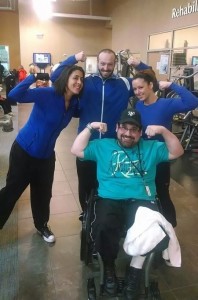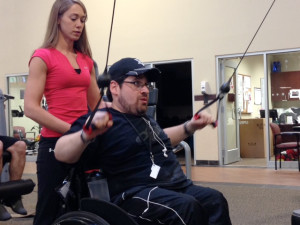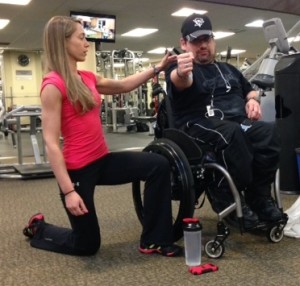by Michelle Sutton-Kerchner
Member Scott Birnbaum shows what can be accomplished, without letting a debilitating disease like spina bifida get in the way …
Facts on Spina Bifida
A common neural tube defect, spina bifida (SB) is a congenital birth defect that affects the spine. It occurs at different locations along the spine, which prevents the spinal cord from forming and closing as it should. The impact SB has on physical and intellectual abilities varies, depending on the size and location of the opening on the spine.
The most common type, spina bifida occulta, is also the mildest. This form often goes undiagnosed until revealed by x-rays taken for a different reason. There is a small gap in the spine, but the spinal cord and nerves remain unaffected. The person’s back does not have a visible opening or sac. Disabilities are not common with SB occulta (SBO).
Meningocele is a type of SB where a sac of fluid protrudes through an opening in the back. The sac does not contain the spinal cord and nerve damage is uncommon. Minor disabilities may be present.
Myelomeningocele is the most severe type of SB. The protruding sac of fluid on the back contains part of the spinal cord and nerves, both of which are damaged. Moderate to severe disabilities are involved, including bladder and bowel issues, lack of feeling in legs and feet, and paralysis of the legs.
Myelomeningocele is the form most associated with SB. The general population is unaware this condition can exist without myelomeningocele’s life-impacting consequences, such as through the mild form of occulta. It can be shocking for those who inadvertently discover, via unrelated diagnostic testing, they have SBO. Approximately 15 percent of Americans have SBO but are unaware until a random back x-ray reveals the small spinal gap, according to the Spina Bifida Association of America.
Scott’s Story (Prepare to Be Motivated)
Member Scott is an inspiration to all. He lost weight and increased muscle mass. Now, he strives to compete in an NPC bodybuilding competition. Scott is paraplegic.
As a result of SB myelomeningocele, Scott endures complete paralysis of the lower half of his body. What gets his other half moving? Positive attitude and sheer determination. With these traits cultivated, he has managed to stay active his entire life. As a child, he was a swimmer and used leg braces to participate in track. In his 20s, Scott hit the road. He joined Lightning Wheels as a wheelchair road racer. Routinely, he accomplishes more activity than some without disabilities.
“It’s hard, but I do what I can,” shares Scott who worked with a physical therapist until he turned 18 years old. Once that stopped, so did Scott’s weight-bearing exercise. His bones got weak, evidenced by a broken hip in May 2013 when Scott fell off a golf cart. (Ironically, he was attending a fundraising event for SB.)
Emergency surgery left him without a hip on one side. Movement was even more difficult, and Scott began to gain weight. His surgeon advised him to lose weight and maintain a healthy body composition. Otherwise, his condition would worsen.

The National Center on Physical Activity and Disability recommends those with SB exercise five times a week, and perform stretching routines three or four times weekly. This is especially pertinent for the wheelchair-bound to remain injury-free and avoid secondary conditions, such as heart disease, obesity, diabetes, pressure sores, and other illnesses related to inactivity. Genetically predisposed to cardiovascular disease and diabetes, Scott has extra motivation to move.
Scott became a Center member and lost 40 pounds working with Trainers Michele Zandman, Christina Sarni, and Randy Frankel. As his introduction to personal training, Randy improved Scott’s technique. Scott shifted from “just going through the motions” to getting results and experiencing benefits. “Randy started me on a healthier path. He showed me how to focus on specific muscle groups to achieve the most from each workout,” shared Scott.
With an award-winning background in fitness competitions, Michele was the catalyst for Scott’s aspirations. “Michele’s enthusiasm is contagious. She got me into competition mode on the Exercise Floor. She inspires me to reach farther,” Scott indicates.
Scott’s work with Fitness Director/Head Trainer Patrice Malone began on January 28, 2014, his thirty-fourth birthday. Since then, Scott gained 11 percent in lean muscle mass. He is progressing toward his latest goal of bodybuilding.
Patrice carefully customized a fitness plan for Scott. “Without use of his lower body, Scott has challenges. However, I certainly can see him on that stage in a year or two [for wheelchair bodybuilding championships].” His exercise program includes strengthening his current mobility, including his core and joints in the upper body. Once mobilization improves where possible, resistance training can be incorporated to stabilize and increase muscle.

Patrice explains,” It’s a two-step process. Increase core activity. This will allow us to isolate and train specific muscle groups using heavier weights and shorter repetitions.” Throughout, careful attention will be given to the rotator cuffs. Risk to those areas increases in these situations.
Those with SB myelomeningocele often suffer emotionally as a result of their condition. Everyone is familiar with the challenges of losing weight, staying committed to fitness, and making healthy choices. As Patrice indicates, “We all are trying to keep up with Scott. He comes to the Center five days a week with a smile, works out for a few hours, and remains positive.” She references other members, with and without disabilities, who are motivated to go further as a result of Scott’s dedication.
“Scott is part of our team. He is an engaging presence at the Center who contributes to our supportive community. As fitness director, I spend a lot of time on administrative responsibilities at my desk. I am fortunate for the opportunity to work with Scott. Being his trainer is a very rewarding experience,” informs Patrice.
Scott makes the most of his Center visits. For him, and many other members, fitness is only part of the experience. He enjoys the social aspect, too. With smarts that match his enthusiasm, he likes chatting technical jargon with Patrice and her team. He is a builder of friendships.
Scott has a role in a community theater play. Patrice will be there with applause. Fitness is not the only achievement on the Exercise Floor. It is genuine caring that establishes true well-being.

As Scott looks to the NPC Wheelchair National Bodybuilding Championship, he recognizes the journey ahead. With a fitness plan and established healthy eating habits (he quit junk food and soda two years ago), he is ready. Scott wants to lose 20 more pounds. However, he recognizes progress is not always reflected on the scale.
“Exercise is key to everyone’s emotional, physical, and mental well-being,” he attests. From his wheelchair, Scott manages to accomplish this while being an inspiration to many.
Sources
Spina bifida at www.cdc.gov
Spina bifida at http://www.nlm.nih.gov/medlineplus/spinabifida.html
www.spinabifidaassociation.org
 Fitness & Wellness News Your Source for Fitness News, Wellness News, Health News, and Nutrition News!
Fitness & Wellness News Your Source for Fitness News, Wellness News, Health News, and Nutrition News!




